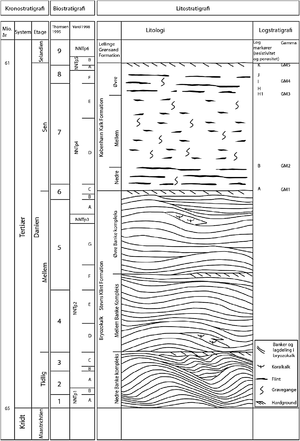Geology and properties of limestone
| Highlights |
|---|
|
Geology and hydrogeologyIn eastern Denmark, glacial Quaternary deposits (clay till, sand) are usually on top of the limestone aquifers. The uppermost limestone layer is typically a carbonated sand limestone (also called Københavns Kalk), followed by a bryozoan limestone. The carbonated sand limestone is rather evenly and horizontally layered and may contain flint layers and nodules. The bryozoan limestone, in contrast, has typically bank structures and few to no flint inclusions. A good description of the geologic stratification in the greater Copenhagen area is given in the Report by GEO and GEUS [1] (in Danish). Figure 1 shows the typical krono-, bio- and lithostratigraphy in eastern Zealand (Denmark) and in the Øresundsregion. Limestone geologies are often heavily fractured and can include almost impermeable chert layers and nodules. The chert can appear as layers that stretch over a distance of tens to hundreds of meters or as loose inclusions embedded in the limestone. Figure 2 shows some borehole cores from the Akacievej site, which illustrate the heterogeneity of the limestone with flint layers, crushed material and fractures. Note that some of the fractures and crushing is caused by the drilling. In fractured limestone geologies, flow predominantly occurs in the fractures, because they provide a much higher hydraulic conductivity than the limestone matrix. Two different kinds of fractures can be distinguished: horizontal fractures often caused by decompression, and vertical/subvertical fractures, typically caused by tectonic activities. Especially the vertical and subvertical fractures can influence the anisotropic behavior of limestone aquifers, because the dominating flow is guided through the fractures. Due to that it is possible, that the main flow direction differs from the overall hydraulic head gradient, and the direction of the major fractures has to be considered. The orientation of the vertical fractures is, as a rule of thumb, often aligned with major faults in the area [1].
Properties of limestoneLimestone aquifers are often very heterogeneous and the hydraulic parameters can span over wide ranges. Moreover, they can have a strong spatial variation, both, vertically and horizontally. The limestone matrix has typically a very low hydraulic conductivity, which can be several orders of magnitude higher than the matrix conductivity. Limestone has a relatively high porosity (8-40 Vol.-%), the porosity of the fractures is comparably low (0.5-2 Vol.-%). Limestone aquifers are typically anisotropic, which means that their horizontal hydraulic conductivity is about 2 to 10 times as high as in the vertical direction. Based on a set of measurements, hydraulic parameters and transport parameters were determined for the Akacievej site. The employed field methods are described in the Chapters Data acquisition and field methods and Determination of transport parameters and contaminant data. Table 1 gives an overview of values that were determined for the Akacievej site.
The sorption behavior for chlorinated solvents on limestone was examined in Salzer (2013). For chlorinated solvents like PCE, sorption to limestone can be strong (kd values of 0.5-1 L/kg were measured). |

